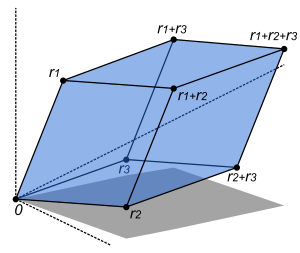Linear algebra (Osnabrück 2024-2025)/Part I/Lecture 16/refcontrol
- The determinant
Suppose an -matrix is given. Can we see "at a glance“ whether it is invertible?MDLD/invertible (matrix) Does there exist an expression in the entries of the matrix to decide this? This question has a positive answer in terms of the determinant.
Let be a field,MDLD/field and let denote an -matrixMDLD/matrix over with entries . For , let denote the -matrix, which arises from , when we remove the first column and the -th row. Then one defines recursively the determinant of by
The determinant is only defined for square matrices. For small , the determinant can be computed easily.

For an upper triangular matrixMDLD/upper triangular matrix
identity matrixMDLD/identity matrix we get
.This follows with a simple induction directly from the recursive definition of the determinant.MDLD/determinant (rec)
- Multilinear and alternatings mappings
Wir führen zwei Begriffe ein, the we im Moment hauptsächlich zum weiteren Verständnis the Determinante brauchen.
Let be a field,MDLD/field and let and be vector spacesMDLD/vector spaces over . A mappingMDLD/mapping
is called multilinear if, for every and every -tuple with , the induced mapping
is
-linear.MDLD/linear (map)For , this property is called bilinear. For example, the multiplikation in a field , that is, the mapping
is bilinear. Also, for a -vector spaceMDLD/vector space and its dual spaceMDLD/dual space , the evaluation mapping
is bilinear.
Let be a field,MDLD/field and let and be vector spacesMDLD/vector spaces over . Let
be a multilinear mapping,MDLD/multilinear mapping and let and . Then
Proof
Let be a field,MDLD/field let and denote -vector spaces,MDLD/vector spaces and let . A multilinear mappingMDLD/multilinear mapping
is called alternating if the following holds: Whenever in , two entries are identical, that is for a pair , then
For an alternating mapping, there is only one vector space occurring several times in the product on the left.
Let be a field,MDLD/field let and denote -vector spaces,MDLD/vector spaces and let . Suppose that
is an alternating mapping.MDLD/alternating mapping Then
Due to the definition of alternating and Lemma 16.6 , we have
- The determinant is an alternating mapping
We want to show that the recursively defined determinant is a multilinear and alternating mapping. To make sense of this, we identify
that is, we identify a matrix with the -tuple of its rows. Thus, in the following, we consider a matrix as a column tuple
where the entries are row vectors of length .
Let be a field, and . Then the determinantMDLD/determinant
is multilinear.MDLD/multilinear This means that for every , and for every choice of vectors , and for any , the identity
holds, and for , the identity
Let
where we denote the entries and the matrices arising from deleting a row in an analogous way. In particular, and . We prove the statement by induction over , For , we have and
due to the induction hypothesis. For , we have and . Altogether, we get
The compatibility with the scalar multiplication is proved in a similar way, see Exercise 16.22 .
We proof the statement by induction over , So suppose that and set . Let and with be the relevant row. By definition, we have . Due to the induction hypothesis, we have for , because two rows coincide in these cases. Therefore,
where . The matrices and consist in the same rows, however, the row is in the -th row and in the -th row. All other rows occur in both matrices in the same order. By swapping altogether times adjacent rows, we can transform into . Due to the induction hypothesis and Lemma 16.8 , their determinants are related by the factor , thus . Using this, we obtain
The property of the determinant to be alternating simplifies its computation. In particular, it is clear how the determinat behaves under elementary row operations. If a row is multiplied with a number , the determinant has to be multiplied with as well. If two rows are swapped, then the sign of the determinant changes. If a row
(or a multiple of a row)
is added to another row, then the determinant does not change.
Let be a field,MDLD/field and let denote an -matrixMDLD/matrix
over . Then the following statements are equivalent.- We have .
- The rows of are linearly independent.MDLD/linearly independent
- is invertible.MDLD/invertible (matrix)
- We have .
The relation between rank, invertibility and linear independence was proven in Corollary 12.16 . Suppose now that the rows are linearly dependent.MDLD/linearly dependent After exchanging rows, we may assume that . Then, due to Theorem 16.9 and Theorem 16.10 , we get
Now suppose that the rows are linearly independent. Then, by exchanging of rows, scaling and addition of a row to another row, we can transform the matrix successively into the identity matrix. During these manipulations, the determinant is multiplied with some factor . Since the determinant of the identity matrix is , due to
Lemma 16.4
,
the determinant of the initial matrix is .

In case , the determinantMDLD/determinant is in tight relation to volumes of geometric objects. If we consider in vectors , then they span a parallelotope. This is defined by
It consists of all linear combinationsMDLD/linear combinations of these vectors, where all the scalars belong to the unit interval. If the vectors are linearly independent, then this is a "voluminous“ body, otherwise it is an object of smaller dimension. Now the relation
holds, saying that the volume of the parallelotope is the modulus of the determinant of the matrix, consisting of the spanning vectors as columns (or rows).
For a proof of the relation between determinant and volume just mentioned, see Fact *****.
| << | Linear algebra (Osnabrück 2024-2025)/Part I | >> PDF-version of this lecture Exercise sheet for this lecture (PDF) |
|---|
































































































![{\displaystyle {}P:={\left\{s_{1}v_{1}+\cdots +s_{n}v_{n}\mid s_{i}\in [0,1]\right\}}\,.}](https://wikimedia.org/api/rest_v1/media/math/render/svg/1d7c1533b8af048ed4fc61742f66f81d77814f0a)
